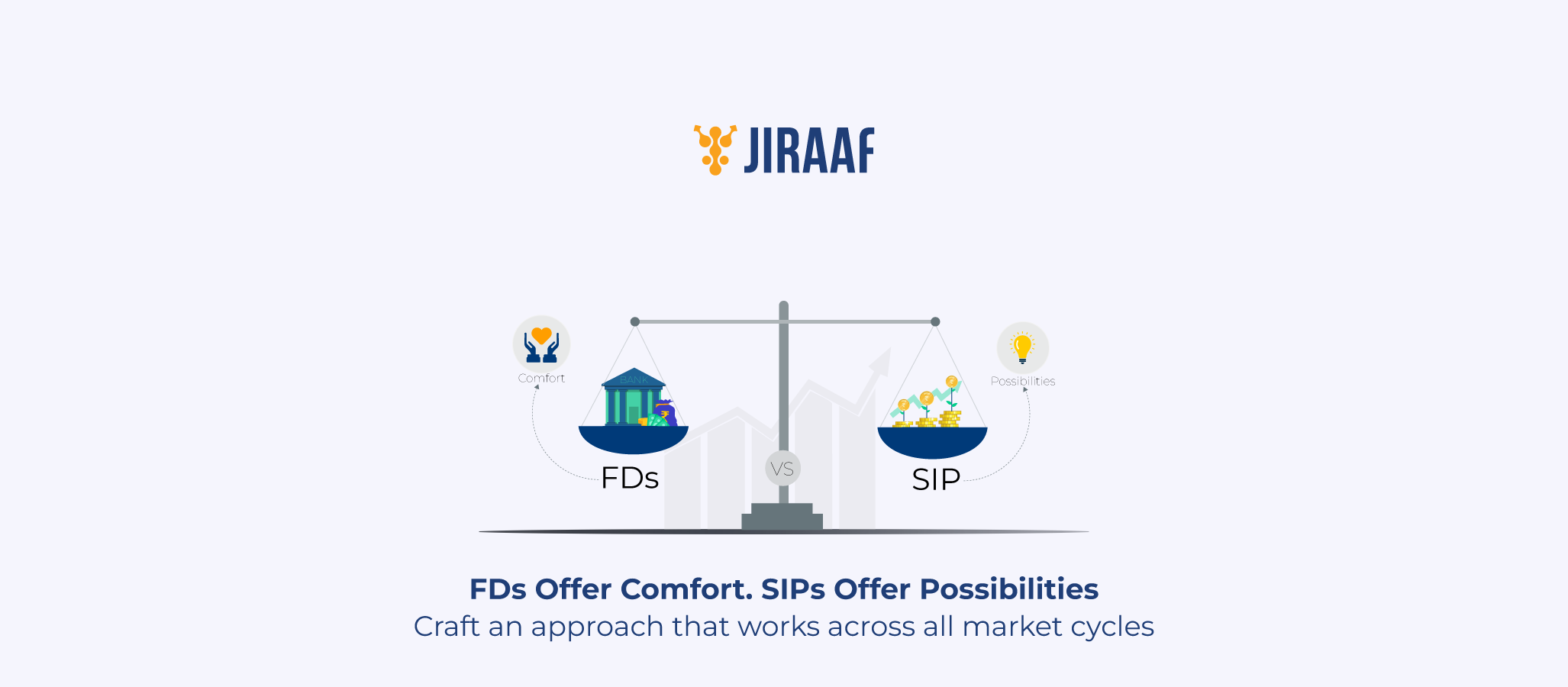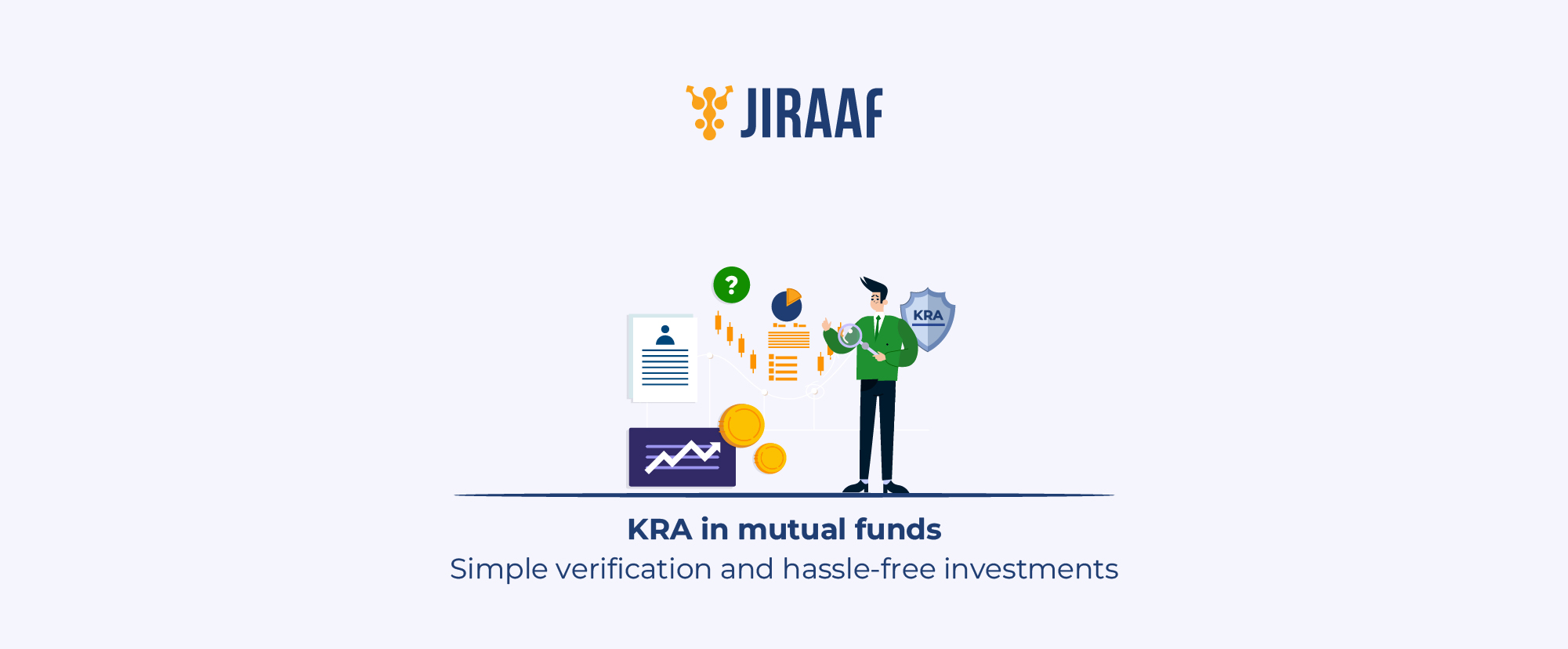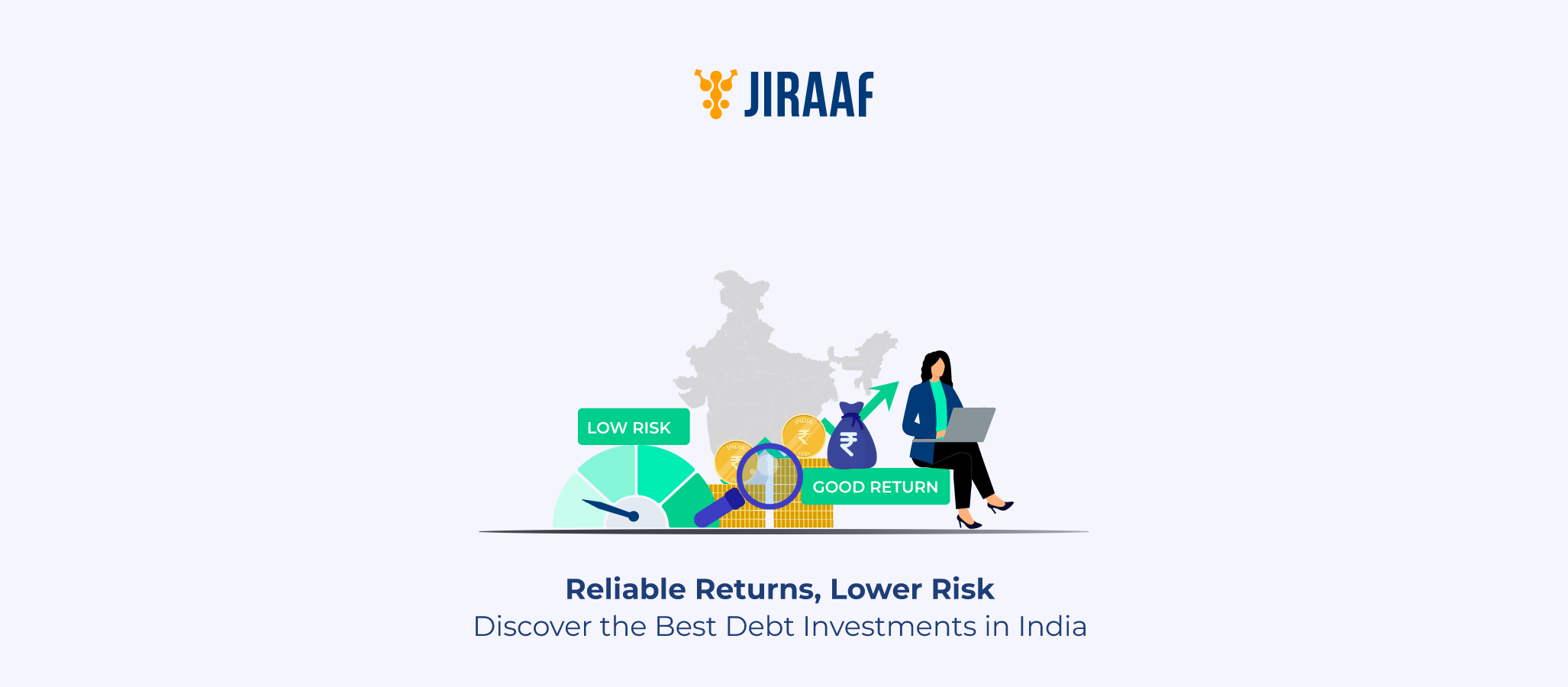You would expect the choice between traditional FDs and SIPs to be a simple enough matter of safety vs. risk, but for savvy investors, it runs deeper than that. You need to consider factors like the purpose, time horizon, taxation, real returns, and your overall personal finance strategy.
As of April 2025, investors have parked ₹180 lakh crore in bank deposits, as a legacy to their safety-first mindset. Simultaneously, mutual fund SIP inflows are consistently crossing ₹20,000 crore every month, pointing to a fundamental shift in investor behavior.
With investors increasingly choosing to allocate parts of their portfolios to both these assets, it’s becoming clear that they don’t want to just pick one or the other, and rightly so. The decision to invest in an SIP or FD should be based on not just returns (or any one factor), but on how well each option aligns with your goals. Let’s see which option best suits you.
What is a Fixed Deposit?
A fixed deposit is a capital preservation tool offered by banks and NBFCs. With FDs, you invest a lump sum at a fixed interest rate for a predefined tenure. The biggest advantage you get from it is certainty, through predictable returns, no market exposure, and optional monthly or quarterly payouts.
Currently, interest rates for traditional bank FDs in India range from 6.5% to 7.5% per annum for tenures between 1 and 5 years. Small finance banks and NBFCs offer higher rates than traditional banks, though often with trade-offs in accessibility or credit risk. Senior citizens typically get a 0.25%–0.5% higher return on all FDs they invest in.
However, traditional bank FDs are not necessarily inflation-proof, especially after tax deductions. This is, in fact, one of the major drawbacks of FDs. If you are in the 30% tax bracket and inflation is 6%, your real post-tax return may be negligible or even negative. This is the silent erosion risk that traditional bank FDs carry when used as long-term instruments.
Regular bank FDs are best suited for:
- Short-term goals (1–3 years)
- Emergency fund parking
- Retirees seeking predictable income
- Conservative investors with limited market exposure tolerance
But, for long-term wealth building, their growth potential is inherently capped.
What is a Mutual Fund Systematic Investment Plan (SIP)?
An SIP lets you invest a fixed amount in mutual funds, primarily equity, hybrid, or debt funds, at regular intervals. SIPs are designed to leverage rupee cost averaging (buying more units when prices are low and fewer when high), long-term compounding, and diversifying the risk involved.
The key advantage of SIPs lies in their ability to help you:
- Stay invested across market cycles
- Build discipline without timing the market
- Accumulate wealth gradually, with lower entry barriers
Historically, equity SIPs in India have delivered annualized returns of 10%–14% over 10+ years, depending on the fund category and market cycle. SIPs offer you the flexibility to pause, top up, or redeem at any time (except in lock-in funds like ELSS), making them far more adaptable than traditional endowment insurance policies, which typically offer lower returns, limited liquidity, and rigid terms.
Regular Bank FD vs SIP: Side-by-Side Comparison
Here’s a side-by-side comparison of both these investment products, analyzing their risk, returns, taxation, and other essential components.
| Parameter | Fixed Deposits | Systematic Investment Plans |
| Risk | Very low (bank/government-backed) | Moderate to high (market-linked) |
| Returns | 6.5%–7.5% annually (pre-tax) | 10%–14% annualized (long-term equity SIP) |
| Liquidity | Early withdrawal penalties | High liquidity (open-ended funds) |
| Taxation | Interest taxed as per the income slab | STCG (15%) if held for ≤1 year (equity funds); LTCG (10% on gains >₹1 lakh) if held >1 year; debt funds taxed at 12.5% LTCG after 3 years (no indexation); fund-specific rules |
| Volatility | None | Subject to market movements |
| Ideal For | Capital protection, short-term savings | Long-term wealth creation |
This comparison shows that both instruments serve different financial objectives. The better option depends on whether you prioritize stability, returns, liquidity, or tax efficiency.
Risk Factor
Traditional bank FDs would be an ideal asset for you if you are looking for capital preservation, either as a short-term strategy or to cushion your portfolio from market volatility and shocks due to their risk profile. However, one needs to watch out for reinvestment risk at lower interest rates, especially during easing cycles.
SIPs are exposed to market fluctuations but tend to reward long-term investors. For instance, investors who continued SIPs during the 2020 COVID crash saw strong recoveries within 12–18 months. They may carry short-term risk, but over time, volatility smooths out and your returns compound.
If you’re asking which is better, regular FD or SIP, understand this: SIPs involve short-term risk for long-term gain, while traditional bank FDs involve short-term safety but long-term stagnation.
Returns Over Time
Let’s understand this better with two examples.
- FD Investment: ₹10 lakh in an FD for 10 years at 6% compounded annually grows to ₹17.91 lakh (pre-tax).
- SIP Investment: ₹20,000/month in an equity SIP growing at 12% p.a. for 10 years can yield ₹46.07 lakh.
The SIP grows more slowly at first but outpaces in the later years due to compounding. Over 10–15 years, the gap widens exponentially, making SIPs a superior choice for wealth-building goals, such as retirement, education, or home ownership. FDs are linear; SIPs are exponential. That’s the difference in their returns.
Liquidity & Flexibility
FDs lock in your funds for a pre-set tenure. Premature withdrawal is possible, but you would usually incur a penalty, either in the form of lower interest or a fee.
SIPs, especially in open-ended mutual funds, offer far greater flexibility. You can:
- Pause and restart
- Increase SIP amount (step-up SIPs)
- Redeem partially or fully without penalty
Even ELSS funds, despite a 3-year lock-in, offer more flexibility post-maturity. This liquidity makes SIPs ideal for evolving financial circumstances, especially for freelancers or business owners with variable incomes.
Tax Implications
Tax is where the FD vs. SIP debate becomes more nuanced.
For FDs, your interest income is taxed as “Income from Other Sources” and added to your total income. If you fall under the 30% slab, this bites heavily into your effective return.
On the other hand, if you hold SIPs in equity mutual funds for more than 1 year, your gains above ₹1 lakh are taxed at 10% (LTCG). For short-term holdings (<1 year), the tax is 15%.
Post-2023 changes, LTCG is taxed at 12.5% flat after 3 years, without indexation for debt fund SIPs.
Clearly, from a post-tax perspective, SIPs (especially equity-oriented ones) provide more efficient compounding than FDs. For example, a 12% return taxed at 10% (SIP) delivers more than a 7.5% FD return taxed at 30%.
Goal Suitability
This is perhaps the most critical consideration in the SIP investment vs. FD decision-making process.
- FDs are ideal for short-term goals (1-3 years), where safety and predictability matter more than high returns.
- Consider hybrid mutual funds via SIPs or a combination of FD + SIP for your medium-term goals (3-5 years).
- SIPs shine when it comes to long-term goals (5+ years). Equity mutual funds have consistently outperformed inflation and delivered real returns over the long term.
FD or SIP: Which is Better for You?
Almost all investors can benefit from a healthy mix of FDs and mutual fund SIPs in their portfolios. Here’s a list of some profiles and how they could split their allocation:
- Young professionals: Invest primarily in equity SIPs to build long-term wealth through compounding, but also keep a portion in FDs or liquid funds as an emergency reserve, ideally covering 3–6 months of expenses.
- Retirees: Use laddered FDs to generate steady, predictable income. Complement this with SIPs in conservative hybrid or balanced funds to help offset inflation and maintain some growth in the portfolio.
- Parents saving for education: Build a goal-based SIP plan aligned with your child’s education timeline. As the goal approaches, gradually shift part of the corpus into short-term FDs to reduce risk and secure the funds.
- Aggressive investors: Focus on SIPs in mid-cap or small-cap mutual funds for higher growth potential. Use FDs to preserve capital for short-term needs or to lock in gains during volatile markets.
- Freelancers or irregular earners: Maintain flexibility with SIPs or systematic transfer plans (STPs) from liquid funds to manage market exposure. Use FDs to set aside funds for taxes, upcoming expenses, or income smoothing.
Can You Invest in Both FD and SIP?
Not only can you, but you should invest in both FD and SIP if you can find space for them in your portfolio. It’s not about which is better, FD or SIP, but about a balance between the two.
Combining FDs and SIPs allows you to build a portfolio that balances stability with long-term growth. Here’s how this strategy adds value:
- Meets short-term needs without disrupting long-term investments
- Manages behavioral risks, since FDs offer peace of mind, while SIPs require patience through market cycles
- Optimises post-tax returns by diversifying across asset classes with different risk-return profiles
Suggested Allocation Framework (Say for a sum of ₹10 lakh):
Your ideal mix should reflect your financial goals, time horizon, and risk appetite:
Conservative investor:
- ₹6–7 lakh in laddered FDs for capital protection and liquidity
- ₹3–4 lakh in SIPs (preferably hybrid or large-cap equity funds) for modest long-term growth
Moderate investor:
- ₹4–5 lakh in FDs to cover short- to medium-term needs
- ₹5–6 lakh in SIPs in diversified equity funds to build long-term wealth
Aggressive investor:
- ₹2–3 lakh in FDs as a safety net
- ₹7–8 lakh in SIPs across equity funds, including mid-cap/small-cap for higher growth potential
This dual strategy helps you stay invested through market cycles. Your FDs provide a cushion during downturns, while your SIPs power your long-term wealth creation when markets rally.
Conclusion: Choose Based on Goals, Not Just Returns
The debate around FD vs. SIP often focuses too narrowly on returns. But the real differentiator is the alignment of your investment vehicle with your financial goal, timeline, and tax situation.
If you hold too much in low-yield FDs, you may be sacrificing long-term purchasing power. On the other hand, if you’re overexposed to volatile markets without liquidity, you’re courting unnecessary stress. The ideal portfolio combines both FDs for preservation and SIPs for progression.
So, don’t pick one over the other; integrate both. Use FDs as your foundation and SIPs as your engine. That’s how resilient portfolios are built, not just for market cycles, but for life’s changing needs.
Discover fixed income investments with Jiraaf, a SEBI registered online bonds platform that educates and brings access to a wide array of bonds. Sign up today to explore diversified fixed income investment opportunities to support your goal-based wealth creation journey. Start investing!









